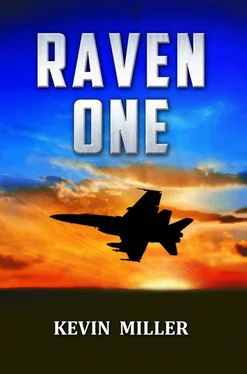“Roger that — break, break — Redeye , four-oh-two. Descend to angels five. Turn right ten degrees to intercept. Keep your knots up.”
“Roger that, Raven … What’s your state?”
“Fumes,” Wilson replied, not far off the truth.
“Roger, we’re at red-line air speed.”
Wilson knew the only way to affect the rendezvous with the tanker before he flamed out was for the S-3 to meet him over the coast. That would mean a third American violation of Iranian airspace during the past 30 minutes. Screw it , he thought. The damage is done.
But would Redeye 704 comply? Wilson needed to know. “Seven-oh-four,” he said with meaning. “I need you to help me in here.”
“No worries, Raven ,” came the reply.
Wilson could not wait to find out who was in 704 . He planned to buy them a drink in the next liberty port. However, right now, he had to face the reality of a possible ejection in the next five minutes. He removed his kneeboard and placed it on the right console. He had worn that kneeboard on his right knee since flight school, and he would hate to lose it forever if he needed to blast himself out of the cockpit. However, there was just no need for it during an ejection.
“Flip, Cajun.” The skipper was calling on tac frequency, which meant he was still on deck monitoring what he could from the line-of-sight radio transmissions.
“Yes, sir, on the bingo descent. Still feet dry. Less than four hun’erd pounds. Redeye joining.”
“Roger, glad you’re okay. Will let you fly the jet… Get out when you have to.”
“I think Prince is gone, sir. Didn’t see a chute,” Wilson added.
“Roger, take care of yourself now. We’ll talk about it when you’re back.”
Wilson thought about the CO absorbing the probable loss of one of his pilots, one of his kids. Prince was a favorite of no one, but even now, in extremis, Wilson was already mourning him. He was almost certain Prince had not survived the aircraft break-up to eject. In fact, he feared Prince had already frozen to death from the well-below-zero outside air temperature that had worked its way into the unpressurized cockpit. Wilson recalled the image of Prince slumped over in his ejection seat just before the missile impact.
He had to put Prince out of his mind when he saw the S-3 transition into the 20-mile radar scale as the Viking raced to meet him with its life-saving fuel. Things were going to happen fast now, and this was his only chance. He bumped the stick to sweeten the intercept heading.
Suddenly GUARD erupted. “ Redeye seven-zero-four, this is Mike One Kilo. You are standing into danger! Turn right to two-seven-zero!”
Damn, Wilson thought. That small-boy still doesn’t have the picture . Wilson ignored the transmission and hoped 704 would do the same. He noticed, for the first time, the muscle tension that had built up in his body over the past 30 minutes. It had seemed to localize in his right shoulder and neck region, and he rubbed his shoulder through the torso harness strap.
Wilson visually picked up the Viking inside 15 miles, a speck against the white haze on the western horizon. Thankfully, it was descending as Wilson had instructed. He rolled the jet up to check below him and saw a dirt road meandering along the coastal plain. His inspection found nothing on it — no motion whatsoever.
Now five miles from the coast, he called to the Redeye tanker. “Seven-oh-four, I’m gonna call your turn. Maintain air speed. On my signal, I’ll need you to break right and bleed to extend the basket. I plan to be on your left wing when you roll out.”
“Roger that, Raven. Standing by,” Redeye replied.
The aircraft were approaching each other fast, but once Wilson gave the order to break right, he would have no other options; he would be committed to the join up. Without extra fuel, Wilson had to plan it perfectly. He would have to direct the S-3 to roll out and to slow to the basket extension speed of 225 just as Wilson got there. The radar scale decremented to 10 miles, and the small rectangular “brick”—that signified the S-3–was now moving fast toward him. He looked outside and saw the S-3 on a collision course. The Viking was at five miles with lots of closure, and Wilson fought the urge to have him break well in front of him. C’mon, c’mon… now!
“ Redeye , break right heading two-three-zero. Go!” Wilson commanded.
“Roger.”
Immediately the S-3 threw his left wing up and pulled hard away from him and toward the water. Wilson watched the S-3 roll up and pull, streaming thin vapor trails from the wingtips. He checked into him a few degrees but held his rate of descent and air speed as he drew closer. Wilson’s eyes were outside now assessing the closure, and he saw the Viking roll out a quarter-mile ahead and below him, speed brakes open and slowing to extend the basket.
“ Redeye , check left ten,” Wilson called to sweeten the rendezvous.
“Roger, Flip, checkin’ left.”
Wilson approached the S-3 one thousand feet above at his 7 o’clock, his fuel indicating only 250 pounds. He pushed the nose over to gain a few more knots of closure, almost directly above the tanker and practically came down on top of it. Sensing the development of an overshoot, he extended the refueling probe to slow himself, and the increased drag of the probe bled a few knots. Because he was in danger of passing the tanker, he popped the speed brake for a few seconds and then retracted it to remain co-air speed.
Wilson fed in top rudder to bleed air speed and descend, and the Viking extended the basket from the wing-mounted refueling store, which payed out the basket via a 40-foot hose into the airstream.
“Hold that air speed,” Wilson said.
“Roger.”
Wilson noticed, while holding top rudder and assessing closure, that they had passed over the coastline. At least we are feet wet, Wilson thought, He took another glance at the fuel—180 pounds. This is it.
Wilson pushed the nose down for the final 50 feet and pulled it back up to level himself as he slid behind the tanker and stabilized. Bringing the throttles up for the first time in ten minutes, he placed the probe three feet behind the basket, which was mercifully steady in the clear air. He goosed the power and gripped the stick as he maneuvered his probe inches from the basket. He was surprised one or both of the engines hadn’t failed yet due to fuel starvation. He then gave it a shot of power and rammed the probe home. The impact caused the hose to make an undulating sine-wave motion back to the store. When he didn’t see the green transfer light on the store, he thought, for an instant, of backing out for one more shot to seat the probe. Then it illuminated, and a sense of relief flooded over him. The fuel gauge increased to 240, 280, 350…
“ Departure , four-oh-two’s plugged and receiving,” Redeye 704 called to the ship.
“Roger Redeye , you are cleared to give 5,000.”
The S-3 began a shallow right turn toward the ship. Wilson, still plugged in, concentrated on staying in position behind the store to receive fuel. Although he took glances at the fuel gauge— passing 1,000 pounds! — he did not have to think for a moment. Let someone else navigate, he thought . Let someone else talk on the radio .
At that moment the same distinctive Iranian voice came up on GUARD and jolted Wilson back to reality: “U.S. Navy warplanes, you are leaving the Tehran Flight Information Region and Islamic Republic airspace. Contact Bahrain FIR on frequency three-one-seven-point-five. We hope you enjoyed your stay. Please come again.”
Читать дальше












